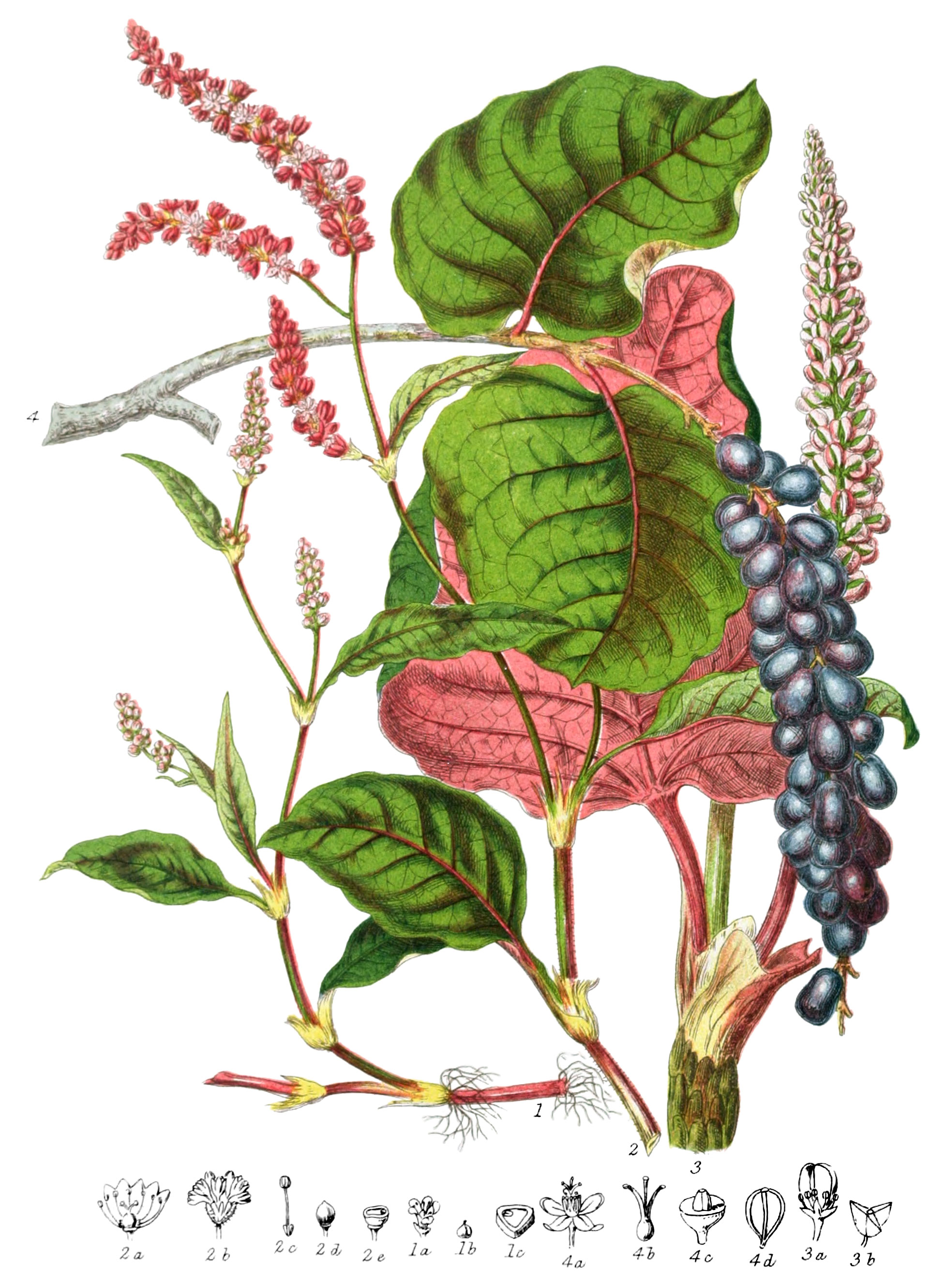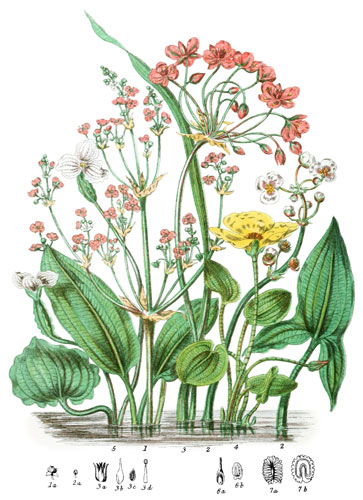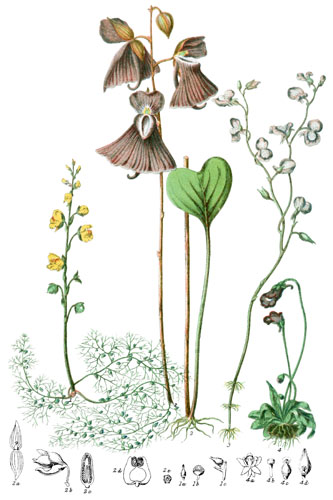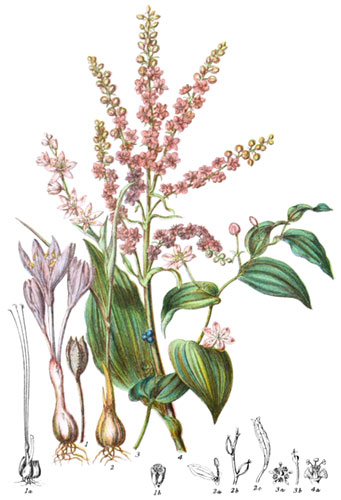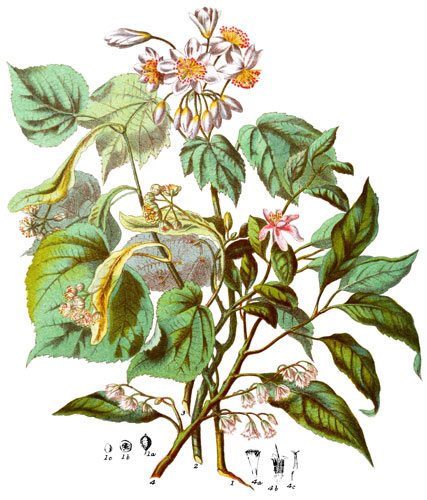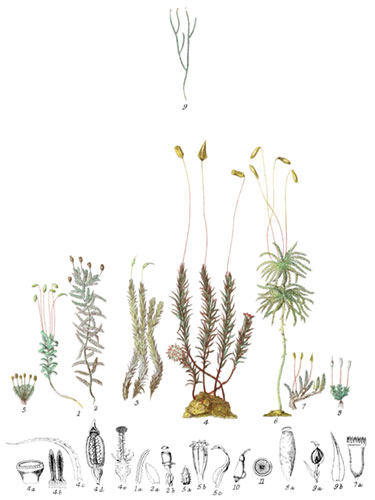Key characteristics
Herbaceous plants and a few shrubs. The leaves are alternate, with scarious stipules cohering round the stem, occasionally wanting. The flowers are in racemes, occasinally solitary; the stamens and pistil are sometimes in different flowers. The corolla is wanting, the calyx often coloured and assuming the appearance of petals, from three to six-parted. The stamens are usually of definite number, placed on the bottom of the calyx; the filaments are free and straight, the anthers opening lengthwise. The ovary is of one cell, formed by the adhesion of three carpels; the styles or stigmas of the same number as the carpels. The fruit is a nut, either naked, or partially covered by the enlarged calyx, or wholly enclosed in it, as in Coccoloba. The seed is single, and contains farinaceous albumen.
This Tribe has affinity with Chenopodiaceæ; Eriogonum forms a link with Nyctaginaceæ, having no stipules.
Agreeable acid qualities exist in the leaves and stalks, nauseous medicinal properties in the roots; some of the plants are also powerfully astringent.
Select plants in this order
Not all plants listed are illustrated and not all plants illustrated are listed.
- Polygonum, so called from the many joints of the stem, is a genus widely scattered over all Temperate countries, attaining higher development of size and colour in hotter climates.
- P. Persicaria (1) is common in ditches and watery places, growing two feet in height; having a fibrous root, occasionally sending out rootlets from the joints.
- P. amphibium is the finest British species; raising its numerous erect spikes of pink flowers above the water, the stem spreads to a considerable extent, roots proceeding from all the joints. It is almost impossible to extirpate it; even from alluvial land, drained for many years, it will continue to spring up. It is said that waterfowl eat the seeds.
- P. hydropiper is very generally to be seen in ditches; the whole plant is covered, more or less, with glandular pores, containing an intensely acrid juice, from whence it was named Water-pepper. The long slender spike of small greenish flowers distinguishes it from other species.
- P. aviculare, Knot-grass, is one of the most frequent of weeds, growing almost everywhere, in waste and cultivated ground, the prostrate stems growing their numerous branches in every direction. The angular black seeds furnish an abundant supply of food to small birds.
- P. Convolvulus is a climbing species, usually to be found in osier grounds.
- P. orientale (2) is the Persicaria of our gardens, having been brought from the East in the beginning of the eighteenth century; it is often as much as ten feet in height, far surpassing the British species in size and beauty.
- Several species in Brazil, as well as in India, are valuable to the natives for their medicinal properties.
- Fagopyrum esculentum has been made a distinct genus from Polygonum, and is the most important of the Tribe, yielding a large proportion of wholesome nourishment in its farinaceous seeds. Originally a native of the East, it has become naturalized here, and often appears in corn-fields. As food for pheasants, it is cultivated in some parts of the country; but in Belgium it is much grown, and the flour obtained from the seeds is made into cakes; it is a remarkably beautiful crop, the bright red stalks bearing their graceful spikes of pink and white flowers. In North America it is still more generally used for cakes: English crumpets are no longer made of Buck-wheat, as formerly.
- Rheum is said to have derived its name from Rha, the ancient name of Volga, on the banks of which the famous root was discovered in abundance.
- R. palmatum is the species from whence the chief supply is obtained on the mountains in Tartary; in China, also, the plant is much cultivated; the roots are generally taken up twice in the year, stripped of their bark, and dried in the air.
- R. spiciforme (3) grows on the northrn slopes of the Himalayas; the roots are of compact texture and light colour, and possess the usual properties.
- Coccoloba uvifera (4) grows in the estuaries of salt water or on sandy shores in South America and the Isles of the Caribbean Sea: saline particles are essential to its perfect development, for whenever it is found in an inland situation it produces only leaves, no flowers. The French colonists call it Raisin du bord de la mer; the enlarged calyx entirely encloses the seed, and forms a pulpy fruit, in appearance like grapes, of an agreeable sub-acid flavour. The trees are tall and branching, the wood is hard and heavy, but of little use; when boiled, it imparts a red tint to water.
- C. excoriata is found by the side of torrents in St. Domingo; this species, and also C. obtusifolia, exhibit close affinity to Polygonum, the pink calyx not wholly enclosing the black seed, nor becoming so pulpy as in C. uvifera.
- Several other species are natives of the West Indies.
- Rumex contains some troublesome weeds, as docks, and some eatable herbs much used in Continental cookery.
- R. scutatus is the French Sorrel, of pleasant acidity; R. acetosa, an English species, the common Sorrel; the astringent roots yield a red dye.
- Oxyria reniformis has strong acid qualities in the leaves; it grows chiefly in the northern situations in various parts of Scotland, and extends far north into the Arctic regions.
- Calligonia Pallasia is a leafless shrub on the Steppes of Siberia, affording food to the Calmuck peasants in the fruit and roots.
- Among the eatable fruits of Eastern Australia described by Mr. Backhouse, is Muhlenbeckia adpressa.
- Sir Robert Schomburgk found the stem and branches of Triplaris americana full of hollow cells, which serve as habitations for ants.
Locations
This Tribe is scattered over the wrold in nearly every part: Polygonum and Rumex abounding in Temperate regions; Coccoloba in South America and the West Indies; Oxyria in the dreary regions of the North Pole.
Legend
- Polygonum Persicaria, Spotted Persicaria. England.
- Flower.
- Seed.
- Section of Seed.
- Polygonum orientale, Eastern Persicaria. East Indies.
- Flower opened.
- Cluster of Flowers.
- Stamen.
- Ovary.
- Section of Seed.
- Rheum spiciforme, Spiked Rhubarb. Himalayas
- Flower.
- Section of Ovary.
- Coccoloba uvifera, Sea-side Grape. West Indies.
- Flower.
- Pistil.
- Seed-vessel.
- Seed.
Explore more
Posters
Decorate your walls with colorful detailed posters based on Elizabeth Twining’s beautiful two-volume set from 1868.
Puzzles
Challenge yourself or someone else to assemble a puzzle of all 160 botanical illustrations.
